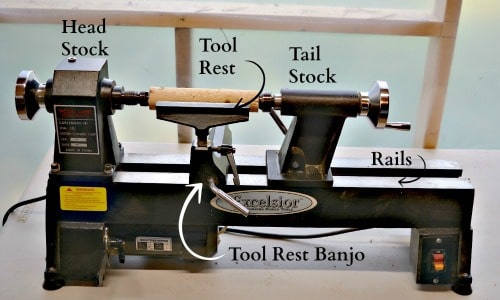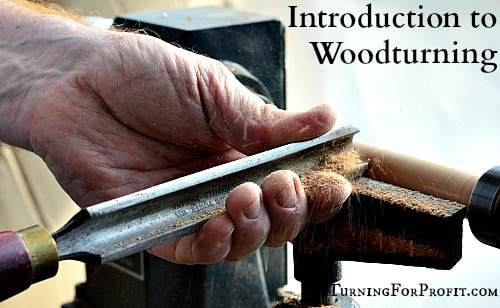So you’ve heard about wood turning and you’re curious to give it a try? Well, you’re in the right place! In this article, we’ll explore the exciting world of wood turning and answer the burning question: what do you need to start wood turning?
Wood turning is a fascinating craft that allows you to shape wood into beautiful, functional objects like bowls, pens, and furniture legs. But before you dive in, it’s important to have the right tools and equipment.
To get started with wood turning, you’ll need a few key essentials. We’ll walk you through everything from the lathe, which is the main tool for wood turning, to the various turning chisels and accessories that will help you bring your creations to life.
Whether you’re a beginner or have some experience, this article will provide you with all the information you need to embark on your wood turning journey. So let’s get started and discover what it takes to become a wood turner!
Are you interested in wood turning but don’t know where to start? To begin your wood turning journey, you’ll need a few essential tools and materials. First, you’ll need a lathe, which is the central tool for wood turning. Additionally, gather some wood blanks, turning tools, a chuck, a face shield, and sandpaper. These items will help you get started on your wood turning projects. Happy turning!

What Do You Need to Start Wood Turning?
Welcome to the world of wood turning! Whether you’re a seasoned carpenter or a novice DIY enthusiast, wood turning is a fascinating craft that allows you to create beautiful and functional objects out of a block of wood. However, before you can get started on your wood turning journey, there are a few essential tools and materials you’ll need to gather. In this article, we’ll walk you through everything you need to know to get started with wood turning.
The Lathe: The Heart of Wood Turning
The first tool you’ll need to start wood turning is a lathe. A lathe is a machine that spins the block of wood while you shape it with cutting tools. There are many types and sizes of lathes available, so it’s important to choose one that suits your budget and preferences. When selecting a lathe, consider factors such as the size of the projects you intend to make, the available space in your workshop, and your level of expertise. It’s also essential to invest in a lathe with a powerful motor and a sturdy construction to ensure smooth and accurate turning.
Along with the lathe, you’ll also need a set of lathe chisels. These specialized cutting tools come in various shapes and sizes and are essential for shaping the wood on the lathe. Some common types of lathe chisels include gouges, parting tools, and skew chisels. As a beginner, it’s advisable to start with a basic set of chisels that includes a few essential types. As you gain more experience and tackle different projects, you can expand your collection to include more specialized chisels tailored to specific tasks.
Working Safely: Protecting Yourself and Others
Wood turning can be a highly enjoyable and fulfilling activity, but it’s essential to prioritize safety while working with spinning wood and sharp tools. To protect yourself, your eyes, and your lungs, it’s important to wear safety gear such as safety glasses or goggles, a dust mask or respirator, and ear protection. These protective measures will shield you from wood chips, dust, and noise generated during the turning process.
Stocking up on Materials and Supplies
Once you have your lathe and cutting tools, it’s time to stock up on the necessary materials and supplies. Wood is the primary material used in wood turning, and there’s a wide variety of wood species to choose from. Each wood species has its own unique characteristics, such as grain patterns, hardness, and color. Some popular choices for beginners include maple, birch, and walnut. It’s a good idea to start with softer woods that are easier to turn and gradually progress to harder and more challenging species.
In addition to wood, you’ll also need sandpaper or sanding pads to achieve a smooth and polished finish on your turned objects. Grits ranging from coarse to fine should be used sequentially to remove any rough spots and achieve a silky-smooth surface. Lastly, don’t forget about wood finishes such as varnish or lacquer to protect and enhance the natural beauty of the wood. Experiment with different finishes to find the one that best suits your preferences.
Sharpening and Maintenance: Keeping Your Tools in Tip-Top Shape
One crucial aspect of wood turning that often gets overlooked is sharpening and maintaining your cutting tools. Sharp tools are essential for achieving clean cuts and preventing accidents. To maintain sharpness, invest in a grinder or a sharpening system specifically designed for lathe chisels. Regularly inspect your tools for any signs of wear or damage, and replace or repair them as necessary. Proper maintenance and sharpening will significantly enhance your wood turning experience and ensure the longevity of your tools.
Choosing the Right Wood Turning Projects
Now that you have all the necessary tools and materials, it’s time to choose your first wood turning project. As a beginner, it’s best to start with simple and small projects that allow you to practice basic woodturning techniques. Some popular beginner projects include pens, bottle stoppers, and small bowls. As you gain confidence and skills, you can gradually move on to more complex projects such as vases, platters, and furniture components.
Joining a Wood Turning Community: Learning and Sharing
Wood turning is a craft that thrives on community and shared knowledge. Consider joining a local wood turning club or attending workshops and demonstrations to learn from experienced turners. The insight, tips, and techniques you’ll gain from fellow enthusiasts will greatly accelerate your learning process and help you overcome any challenges you may face. Additionally, participating in exhibitions and competitions can provide valuable opportunities to showcase your work and receive feedback from experts in the field.
Conclusion
Starting wood turning can be an exciting and rewarding endeavor. By gathering the essential tools, prioritizing safety, stocking up on materials, maintaining your tools, choosing the right projects, and engaging with the wood turning community, you’ll be well on your way to creating beautiful turned objects. So, what are you waiting for? Grab your lathe, sharpen your chisels, and let the wood turning journey begin!
Key Takeaways: What Do You Need to Start Wood Turning?
- Gather the necessary tools and equipment, such as a lathe, chisels, a face shield, and sandpaper.
- Choose the right type of wood suitable for wood turning, like maple or walnut.
- Learn the basic wood turning techniques, including spindle turning and bowl turning.
- Ensure a safe working environment by setting up a sturdy workbench and proper lighting.
- Don’t forget to wear protective gear and follow safety guidelines to prevent injuries.
Frequently Asked Questions
Welcome to our FAQ section on “What do you need to start wood turning?”. Here, we’ll address some common questions beginners have about getting started in wood turning. Whether you’re a woodworking enthusiast or simply curious, we’ve got you covered!
1. How can I get started with wood turning?
If you’re looking to start wood turning, there are a few essential tools and equipment you’ll need. First, you’ll need a lathe, which is the primary machine used in wood turning. Additionally, you’ll need a set of turning tools, such as gouges and scrapers, to shape and smooth the wood. Safety goggles, a dust mask, and ear protection are also important for your safety. Finally, getting the right type of wood, like hardwood or softwood, is crucial for a successful wood turning project. Start with smaller projects and gradually build your skills!
Remember, wood turning can be an enjoyable and rewarding craft, so make sure to take your time and learn proper techniques to ensure both your safety and the quality of your work. Consider taking classes, watching online tutorials, or joining a wood turning community to enhance your skills and knowledge.
2. Can I start wood turning with a small budget?
Absolutely! Wood turning can be pursued on any budget. While a professional-grade lathe and tools can be expensive, there are affordable options available that are suitable for beginners. Look for mini lathes or used equipment, which often come at a lower price point. You can also find budget-friendly turning tools and accessories online or at woodworking stores. Alternatively, consider borrowing tools from a friend or a local makerspace to get started. Remember, it’s more important to focus on learning and honing your skills rather than acquiring expensive equipment right away.
In addition, you can source wood locally, either by salvaging it from fallen trees or acquiring wood scraps from local woodworkers. This will help cut down on costs, especially when starting out. With some creativity, resourcefulness, and a passion for wood turning, you can begin your journey without breaking the bank!
3. How can I ensure safety while wood turning?
Safety should always be a top priority when engaging in wood turning. Firstly, make sure to wear safety goggles to protect your eyes from flying wood particles. Additionally, a dust mask will prevent you from inhaling fine dust particles. Ear protection is crucial, as the noise from the lathe can be quite loud. It’s also important to wear appropriate clothing, such as long sleeves and closed-toe shoes, to protect your skin from sharp tools and flying debris.
Before starting any project, familiarize yourself with the basic safety practices, such as proper tool handling and correct wood positioning. Always keep your hands a safe distance away from the spinning wood, and avoid loose-fitting clothing or jewelry that could get caught in the lathe. Lastly, if you’re unsure or uncomfortable with a particular technique, take the time to practice or seek guidance from experienced wood turners.
4. What types of projects are suitable for beginners in wood turning?
As a beginner, it’s a good idea to start with small and simple projects to build your skills and confidence. You can begin by turning wooden pens, bottle stoppers, or small bowls. These projects allow you to practice basic turning techniques while creating functional items. As you progress, you can move on to more complex projects, such as larger bowls, vases, and even decorative items like wooden ornaments.
Remember, each project is an opportunity to learn and improve your skills. Don’t be discouraged by mistakes; they are part of the learning process. Embrace the journey of wood turning and enjoy the satisfaction that comes with creating something beautiful from a block of wood!
5. Are there any online resources or communities for wood turning beginners?
Absolutely! There is a wealth of online resources and communities available to help beginners in wood turning. You can find a wide range of YouTube channels and woodworking websites that offer tutorials, tips, and project ideas specifically tailored for beginners. These resources can help you learn and improve your skills from the comfort of your own home.
Additionally, consider joining online forums or social media groups dedicated to wood turning. They provide a platform where you can connect, share your work, ask questions, and receive feedback from experienced wood turners. Engaging with these communities not only enhances your learning but also offers a supportive network of like-minded individuals who share your passion for wood turning.

Summary
Starting wood turning is easy! You’ll need a lathe, turning tools, safety gear, and wood.
First, get a lathe – it’s the machine that spins the wood. You’ll also need turning tools like gouges and chisels to shape the wood. Don’t forget to wear safety gear like goggles and a face shield to protect yourself. Last but not least, choose your wood – hardwoods like maple or cherry are great for beginners. Now you’re ready to start turning!
